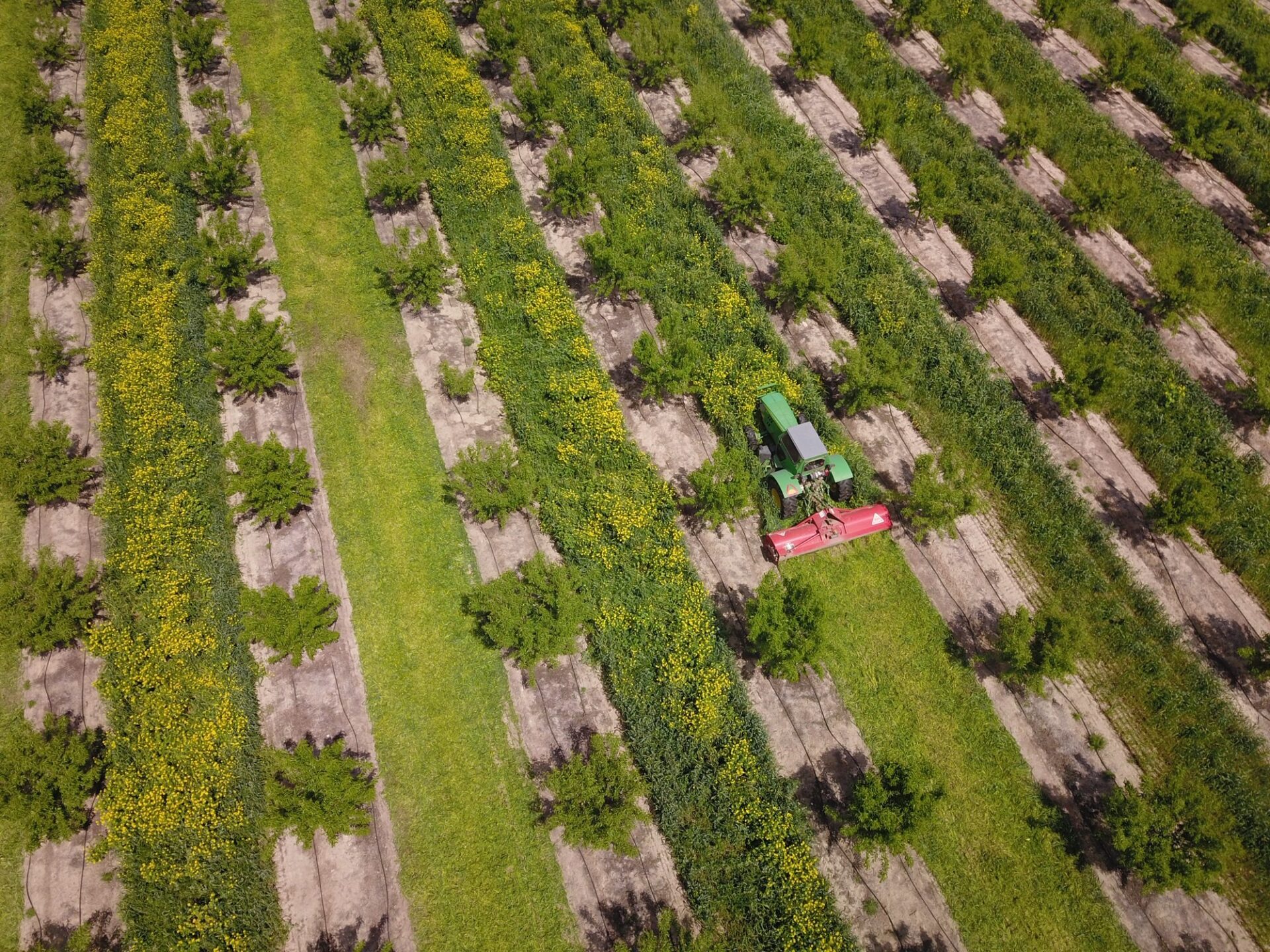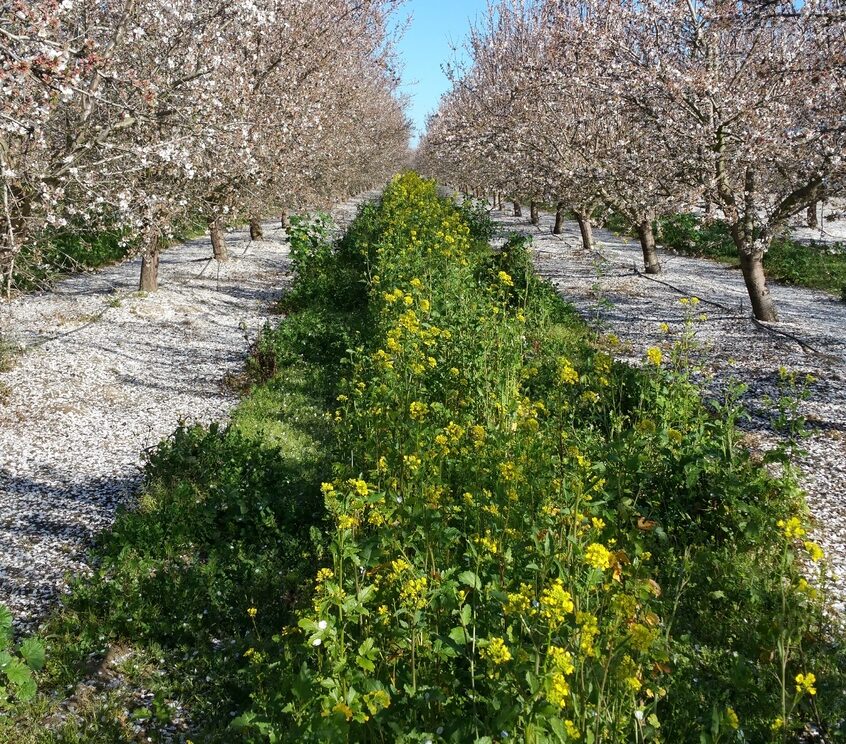
In the past, many growers’ experience with cover crops has started and ended with questions.
“How can I harvest my crop when there is extra vegetation on the orchard floor?”
“I heard having a cover crop in the middles increases the risk of frost damage, is that true?”
“Why would I plant cover crops to compete with blossoms and detract from bees’ almond pollination?”
Formerly, these questions and lingering unknowns kept many growers from considering the use of cover crops in or around their orchards. Today, however, research is delivering answers; after 10 years of investigating cover crops in almond orchards throughout the Central Valley and studying a variety of factors, answers to growers’ questions have been addressed and are culminated in the Almond Board of California’s (ABC) latest resource: the Cover Crop Best Management Practices (BMPs).
The Cover Crop BMPs summarize research funded by ABC, CDFA and others with the goal of defining and refining best practices for cover crop use in almonds. Authored by a team of UC experts led by UC Davis Postdoctoral Fellow Vivian Wauters, this guide outlines the production challenges cover crops address and the additional benefits they can deliver to the orchard. The BMPs then walk growers through the process of implementing cover crops, providing practical explanations of how to get started and scale up as desired.
“This guide builds on recent research and growers’ experiences, which have shown that cover cropping is a feasible practice in California almond systems with potential benefits to growers and the environment. It provides guidance on how cover crops can be managed to address specific objectives and limit tradeoffs in commercial fields,” said co-author Dr. Amélie Gaudin.
Plan, Then Plant
Before purchasing new equipment for their operation, growers ask themselves, “How will this equipment make me more efficient in my day-to-day operations?” or “What does maintenance look like?”
The same approach applies to cover crops. Growers should know what their goals are for using a cover crop and then manage said crop based on those goals. Goals can be thought of in one of two ways: added benefits that cover crops provide, such as reducing soil compaction or enhancing pollinator forage, or problems that cover crops help growers address, like reduced nitrogen losses, nematode suppression, etc.
After growers answer the question of what they want cover crops to accomplish (the purpose and desired benefits), they should look to their operation and consider their orchard’s age, water source/s, existing pest concerns and other factors (further outlined in the Cover Crop BMPs) to select the crop species and mix(es) that will work best within their orchard makeup.
“Growers have many options when choosing cover crop species and mixes, which can make species selection a difficult part of the process. While having a cover crop of any kind can provide some benefit, specific species and mixes can help growers to accomplish specific goals. That is why the BMPs encourage growers to first decide what they need and want from cover crops, and then move to identifying the mix/es and species that will facilitate accomplishing those goals,” said Wauters.
Once growers select their species and mixes, the Cover Crop BMPs will walk them through step-by-step instructions and recommendations on how to seed the crop, grow it and terminate it. From information on seeding equipment and rate to mowing considerations, this resource strives to address all aspects of growing, maintaining and reaping benefits from cover crops.
“Cover crops are not a fit for every grower or every year, and generally depend on late fall rains or irrigation. But the benefit, together with incentives that can defray some of the cost, make it something every grower should at least consider,” said ABC Chief Scientific Officer Josette Lewis, Ph.D.
“With this guide, we hope growers and allied industry members gain a greater sense of all that’s involved with planting cover crops and the ways in which it can deliver optimizations to the orchard. And, like most things in life, at the end of the day growers will get out of it what they put in; more intentional management will lead to more prosperous outcomes.”

Busting Myths, Stating Facts
Throughout this resource, information is provided to address known, existing grower apprehensions or curiosities around the usefulness of cover crops and their ability to fit well within an orchard system.
In terms of concerns that cover crops compete with almond blossoms for honeybees’ attention, industry-funded, ABC-directed research shows that flowering cover crops do not compete with blossoms for bee visitation. In fact, cover crops can enhance bee health by providing pollinators with a supplementary food source during times when pollen is not as ripe for the taking (before and shortly after bloom), giving bees more energy to pollinate during the height of bloom.
Further, among all of growers’ concerns, the top perceived operational constraint to cover crop use is difficulty of harvest due to crop debris. However, as detailed in this resource, cover crops can be mowed to decompose fully and disappear by harvest. While specific timing varies by operation, if growers are intentional about managing their cover crops, they may be able to terminate their cover crop as early as mid-March (depending on their orchard’s needs) to reduce water competition with trees and ensure a clean orchard floor for harvest.
If growers are still on the fence, the next best step may be to give cover crops a try on a small section of the orchard and monitor them for an extended period of time. Because cover crop species and mixes are so varied and able to address a series of challenges in orchards across the growing region, the best way to determine cover crops’ success is to try it out.
And for an increasing number of growers, that decision has paid off.
“I’m a huge believer in cover crops, there are so many positives,” said Chris Rishwain, an almond grower near Manteca who first planted cover crops roughly three years ago. “The cost is minimal. It’s definitely helped with our soil compaction. I see improvement during pollination. And ultimately, we get a lot of bees and a lot of pollination, and at the same time, our beekeeper is happy and says the hive strength is phenomenal.”
Fourth-generation almond grower and owner of Pacific Gold Agriculture Ben King has worked with cover crops for multiple growing seasons. In addition to the benefits he’s seen in his orchard and for both honeybees and natural pollinators, he believes that, “looking long-term, growers need to really consider the benefits of cover crops to their orchards; having a lot more organic material and increased water infiltration is a good thing, both in the present and looking 10, 20 years down the road.”
Stay Tuned: Bee+ Scholarship funds
To support growers in their efforts to promote pollinator health, ABC is offering its Bee+ Scholarship for the second year in a row. Last year, this scholarship allowed 135 new almond growers to join Project Apis m.’s Seeds for Bees program and added pollinator habitat to 14,778 acres of almond orchards, a 22% increase to the footprint of almond pollinator habitat from the prior year.
There are two components to the scholarship: free cover crop seed provided to almond growers through Seeds for Bees and a waived Bee Friendly Farming certification fee through Pollinator Partnership, the world’s largest nonprofit dedicated to pollinators and their ecosystems.
The Cover Crop BMPs and more information on the Bee+ Scholarship can be found online at Almonds.com/Pollination. Growers are encouraged to visit the website and explore all the tools available to support pollinators and increase soil health.
















